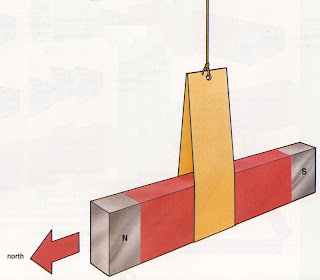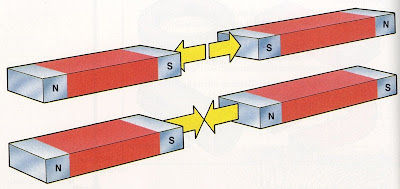We use magnetism in so many ways that modern life would be impossible without it.
We need magnetism to produce large amounts of electricity in power stations.
There are magnets in compasses, loudspeakers, electric motors, refrigerator doors, computer disks, and many other useful appliances.
Magnetism is an invisible force that can make some things move towards each other, or move away from each other, or stay in one place.
We can't actually see magnetism, but we can look at magnets and see what happens to certain things that are put near them.
The area around a magnet is called a magnetic field.
When magnets and some metals are inside a magnetic field, magnetism makes them move.
A strong enough magnet can make steel paper clips jump off a table. This is caused by an invisible force, called magnetism, which surrounds every kind of magnet.
We need magnetism to produce large amounts of electricity in power stations.
There are magnets in compasses, loudspeakers, electric motors, refrigerator doors, computer disks, and many other useful appliances.
Magnetism is an invisible force that can make some things move towards each other, or move away from each other, or stay in one place.
We can't actually see magnetism, but we can look at magnets and see what happens to certain things that are put near them.
The area around a magnet is called a magnetic field.
When magnets and some metals are inside a magnetic field, magnetism makes them move.
A strong enough magnet can make steel paper clips jump off a table. This is caused by an invisible force, called magnetism, which surrounds every kind of magnet.
What are magnets made of?
When a magnet is surrounded by a magnetic field all the time, we call it a permanent magnet. Most permanent magnets are made from steel or from mixtures, called alloys, of iron and other metals.
Many magnets are made from an alloy called Alnico. This contains the metals aluminum, nickel, iron and cobalt. The bold letters show you how we form the name Alnico.
Permanent magnets are made of metal and can make other metals move toward them.
Scientists describe metals that magnets can attract in this way as magnetic. Iron, steel, cobalt and nickel are magnetic.
But not all metals are magnetic.
For example, magnets do not attract aluminum or copper. Scientists describe these metals as nonmagnetic.
You can find out for yourself whether something is magnetic or nonmagnetic.
Hold a small magnet near a piece of paper to see if the paper will move towards the magnet. Now try the same experiment with things made of plastic, glass and cloth.
Are these materials magnetic or nonmagnetic?
Iron filings stick to the ends of a magnet where the magnetic force is strongest.
These ends are called the poles of the magnet.
Many magnets are made from an alloy called Alnico. This contains the metals aluminum, nickel, iron and cobalt. The bold letters show you how we form the name Alnico.
Permanent magnets are made of metal and can make other metals move toward them.
Scientists describe metals that magnets can attract in this way as magnetic. Iron, steel, cobalt and nickel are magnetic.
But not all metals are magnetic.
For example, magnets do not attract aluminum or copper. Scientists describe these metals as nonmagnetic.
You can find out for yourself whether something is magnetic or nonmagnetic.
Hold a small magnet near a piece of paper to see if the paper will move towards the magnet. Now try the same experiment with things made of plastic, glass and cloth.
Are these materials magnetic or nonmagnetic?
Iron filings stick to the ends of a magnet where the magnetic force is strongest.
These ends are called the poles of the magnet.
What shape is a magnet?
Magnets are made in several shapes, including bars, horseshoes, rings, disks, and cylinders.
Magnetism works in a different way around each shape of magnet.
We use bar magnets in compasses, horseshoe magnets in small electric motors, and disk magnets in radio, television, or stereo.
Magnetism works in a different way around each shape of magnet.
We use bar magnets in compasses, horseshoe magnets in small electric motors, and disk magnets in radio, television, or stereo.
Magnetic Poles - North and south poles
Magnetism is strongest at the ends, or poles, of a bar magnet.
Scientists call one end of a bar magnet the north-seeking pole because it always tries to point towards the north.
The other end is called the south-seeking pole.
We call them the north pole and south pole for short.
Do you want to know which end of your bar magnet is the north pole?
You can find out which direction is north with a compass.
Hang the magnet from a piece of string so that it can swing freely. When it eventually stops swinging, the end of the magnet that points north is the north pole of the magnet.
Scientists call one end of a bar magnet the north-seeking pole because it always tries to point towards the north.
The other end is called the south-seeking pole.
We call them the north pole and south pole for short.
Do you want to know which end of your bar magnet is the north pole?
You can find out which direction is north with a compass.
Hang the magnet from a piece of string so that it can swing freely. When it eventually stops swinging, the end of the magnet that points north is the north pole of the magnet.
If you put a metal object made of iron, steel, cobalt or nickel near a magnet, the magnet will pull the metal toward it.
Scientists say that the magnet attracts the metal.
Magnets can also attract other magnets, but sometimes magnets push away from each other.
Then scientists say that the magnets repel each other.
Like and unlike poles
To make a triangle of magnets, each north pole must be next to a south pole. If you try to put two like poles together, the triangle will fall apart.
You can feel two magnets attract each other if you hold the north pole of one magnet near the south pole of another magnet. But if you put two poles of the same kind close together, two north poles or two south poles, then the magnets will repel each other. Scientists have a rule to help us remember this. The rule is, "Like poles repel, unlike poles attract."
You can feel two magnets attract each other if you hold the north pole of one magnet near the south pole of another magnet. But if you put two poles of the same kind close together, two north poles or two south poles, then the magnets will repel each other. Scientists have a rule to help us remember this. The rule is, "Like poles repel, unlike poles attract."
See this for yourself by making a triangle with three bar magnets.
You can't make the magnets stay together if you put two like poles next to each other.
The north pole of one magnet, for example, will always repel the north pole of another magnet.
If you want your magnets to attract each other and stay close together, the north pole of one magnet must be next to the south pole of the other magnet.

















Social Plugin